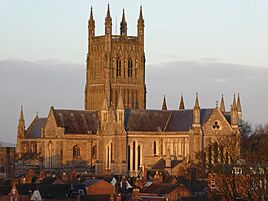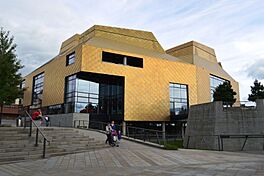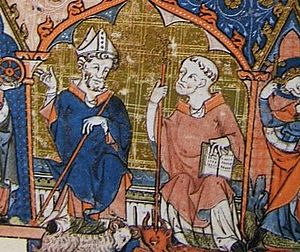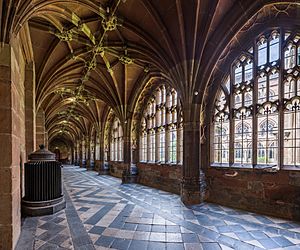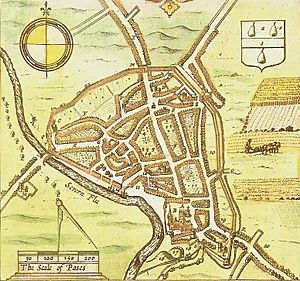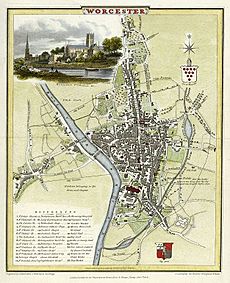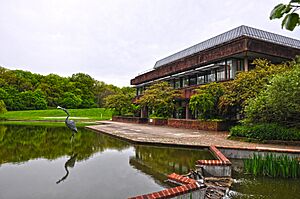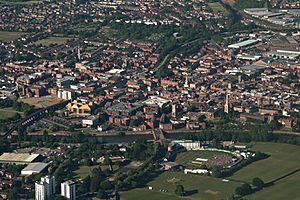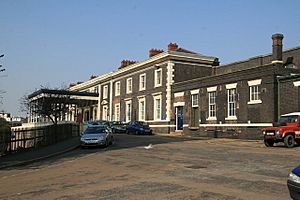Worcester, England facts for kids
Quick facts for kids
Worcester
|
||
|---|---|---|
|
City and non-metropolitan district
|
||
|
|
||
|
||
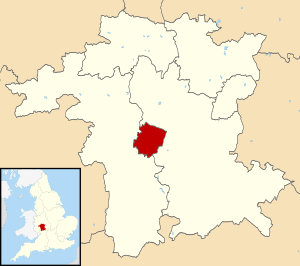
Worcester shown within Worcestershire
|
||
| Sovereign state | United Kingdom | |
| Country | England | |
| Region | West Midlands | |
| County | Worcestershire | |
| Areas of the city |
List
Claines
Diglis Dines Green Henwick Lower Wick Northwick Red Hill Ronkswood St John's St Peter the Great Warndon |
|
| Area | ||
| • Total | 12.85 sq mi (33.28 km2) | |
| Area rank | 305th (of 326) | |
| Population
(2021 Census)
|
||
| • Total | 103,872 | |
| • Rank | 239th (of 326) | |
| • Density | 8,083.8/sq mi (3,121.2/km2) | |
| Ethnicity (2021) | ||
| • Ethnic groups |
List
|
|
| Religion (2021) | ||
| • Religion |
List
48.9% Christianity
39.6% no religion 4.1% Islam 0.4% Hinduism 0.1% Judaism 0.2% Sikhism 0.4% Buddhism 0.4% other 6.1% not stated |
|
| Time zone | UTC0 (GMT) | |
| • Summer (DST) | UTC+1 (BST) | |
| Postcodes |
WR1-5
|
|
| Area code(s) | 01905 | |
| ONS code | 47UE (ONS) E07000237 (GSS) |
|
| OS grid reference | SO849548 | |
Worcester (![]() i/ˈwʊstər/ WUUST-ər) is a historic cathedral city in Worcestershire, England. It is the main town of the county. Worcester is about 30 miles (48 km) south-west of Birmingham. It is also 27 miles (43 km) north of Gloucester and 23 miles (37 km) north-east of Hereford. In 2021, the city had a population of 103,872 people.
i/ˈwʊstər/ WUUST-ər) is a historic cathedral city in Worcestershire, England. It is the main town of the county. Worcester is about 30 miles (48 km) south-west of Birmingham. It is also 27 miles (43 km) north of Gloucester and 23 miles (37 km) north-east of Hereford. In 2021, the city had a population of 103,872 people.
The River Severn flows along the western side of the city centre. The famous Worcester Cathedral overlooks the river. Worcester is known for Royal Worcester Porcelain, which makes beautiful pottery. It is also the home of Lea & Perrins, who make the traditional Worcestershire sauce. The University of Worcester is here, and Berrow's Worcester Journal is published in the city. This newspaper is thought to be the oldest in the world. The famous composer Edward Elgar (1857–1934) grew up in Worcester.
A very important event in English history, the Battle of Worcester, happened here in 1651. This was the final battle of the English Civil War. During this battle, Oliver Cromwell's army defeated King Charles II's Royalist forces.
Contents
- Worcester's Long History
- How Worcester is Governed
- Worcester's Location and Weather
- Worcester's People and Religions
- Worcester's Economy
- Places to Visit in Worcester
- Getting Around Worcester
- Education in Worcester
- Hospitals in Worcester
- Sports in Worcester
- Worcester's Culture
- Twin Cities
- Famous People from Worcester
- Images for kids
- See also
Worcester's Long History
Worcester has a very long and interesting history. People have lived here for thousands of years.
Early Beginnings
A trade route, which later became part of the Roman Ryknild Street, passed through Worcester. This route dates back to the Neolithic period (Stone Age). The city was built near a place where people could cross the River Severn. Around 400 BC, the Britons built a fort here to protect the crossing.
The Romans also used the area. They made pottery and iron goods using charcoal from the Forest of Dean. They might have built a small fort too. By the 3rd century AD, Roman Worcester was quite large. However, floods caused parts of it to be abandoned.
Anglo-Saxon Times
The name of Worcester has changed over time. When the Angles of Mercia settled here in the 7th century, they called it Weogorna. Later, after wars with the Vikings, it became Weogorna ceastre, meaning "Worcester Camp". The Weorgoran people were likely part of the larger Hwicce kingdom.
In 680, Worcester was chosen as the main town for a new bishopric. This shows there was already a strong Christian community.
Worcester became a key place for learning and church power. Oswald of Worcester, who became Bishop in 961, was an important reformer. The last Anglo-Saxon Bishop, St Wulfstan, also worked to improve things.
In 1041, the people of Worcester resisted heavy taxes from the Danish King Harthacnut. They tried to hide on an island in the Severn River. But Harthacnut's men attacked and burned the city. Eventually, an agreement was reached, and the people rebuilt their town.
Medieval Worcester
Worcester grew into an important market town. This was because of its river crossing and bridge. In the 14th century, the closest bridges over the Severn were far away. Major roads also passed through Worcester, connecting it to other parts of England and Wales.
The city was also a centre for religious life. Many monasteries, like Greyfriars and Blackfriars, were here. These monasteries provided hospital care and education. The Benedictine Priory, which is now Worcester Cathedral, was also very important.
The town was attacked several times in the 12th century during a civil war. In 1139, an attack led to a fire that destroyed part of the city. Another fire in 1189 caused even more damage.
Worcester received its first royal charter in 1189. This document gave the town special rights. In 1227, a new charter allowed a guild of merchants to be created. This group had a monopoly on trade, meaning only its members could trade certain goods.
Jewish Community in Medieval Times
Worcester had a small Jewish community in the late 12th century. Their life likely revolved around what is now Copenhagen Street.
The local church leaders were not friendly towards the Jewish community. In 1219, Bishop William de Blois made strict rules for Jews. Like in other parts of England, Jews had to wear special square white badges.
In 1263, a group of barons attacked Worcester's Jewish residents. Most of them were killed. This was part of a larger conflict called the Second Barons' War. By 1275, any remaining Jews in Worcester were forced to leave and move to Hereford.
Life in Late Medieval Worcester
In late medieval times, Worcester had about 1,025 families. This means the population was probably under 10,000 people. The city's suburbs grew beyond its walls.
Making cloth and related trades were very important for the city's economy.
Craft Guilds
In medieval and early modern Worcester, groups called guilds were formed for different crafts. These guilds controlled who could work in a trade. They also set rules for training and trade practices. Guilds also offered social support to their members. For example, the city made rules to encourage tilers (roof makers) to come and work freely in Worcester. They also banned roofs made of thatch and wooden chimneys to prevent fires.
Early Modern Period
During the Dissolution of the Monasteries in the 16th century, the Priory lost its monks. Worcester had to create "public" schools to replace the education provided by the monasteries. This led to the founding of King's School.
In 1621, Worcester gained the right to elect a Mayor. It also became a county corporate, which meant it had more control over its own local government. After this, Worcester was run by a mayor, a recorder, and six aldermen.
Speed's map from 1610 shows that Worcester still had green spaces, like orchards and fields, inside its city walls. The walls were mostly complete, but people had started building outside them.
English Civil War in Worcester
At the start of the English Civil War in 1642, Worcester first sided with Parliament. However, Royalist forces quickly took over the city. Parliament briefly recaptured it after the Battle of Powick Bridge. During this time, they damaged the cathedral, smashing stained glass and destroying the organ and books.
The Royalists soon took Worcester back. The city became a garrison town, meaning it had to house and feed many Royalist soldiers. To make defence easier, the suburbs outside the city walls were destroyed. People faced high taxes, and many men were forced to join the army.
In May 1646, as Royalist power weakened, Worcester was put under siege. About 5,000 civilians and 1,500 Royalist soldiers were inside the city. They faced 2,500–5,000 of Oliver Cromwell's army. The city surrendered on 23 July.
In 1651, a Scottish army of 16,000 men marched south to help Charles II regain his throne. Worcester's council decided to surrender to avoid more fighting. The Scottish soldiers stayed in and around the city.
The Battle of Worcester happened on 3 September 1651. Charles II's forces were easily defeated by Cromwell's much larger army of 30,000 men. Charles II fled in disguise and eventually escaped to France. After the battle, the Parliamentarian army heavily looted Worcester. The city council estimated the damage was £80,000.
After the War: The Faithful City
After the king returned to power in 1660, Worcester used its role in the Civil War to ask for money from Charles II. Even though it wasn't entirely true, the city started calling itself Fidelis Civitas (The Faithful City). This motto is now on the city's coat of arms.
The Worcester Guildhall was rebuilt in 1721. It is a beautiful Queen Anne-style building. It is considered one of the most splendid town halls in 18th-century England.
Worcester's old bridge was replaced in 1781. As the city grew, the green spaces inside the walls were filled with houses. The city walls were mostly removed by 1796. Meanwhile, the Royal Worcester Porcelain Company factory was started in 1751 by Dr John Wall.
Industrial Revolution and Victorian Era
In the late 18th and early 19th centuries, Worcester was a major centre for making gloves. At its peak, over 30,000 people worked in this industry. In 1815, the Worcester and Birmingham Canal opened, helping transport goods.
In 1831, there were riots in response to the defeat of the Reform Bill. This showed people were unhappy with the city's government and wanted more say. Local government was reformed in 1835, allowing councillors to be elected for the first time.
The British Medical Association (BMA) was founded in Worcester in 1832.
Railways arrived in Worcester in 1850 with the opening of Shrub Hill. This station first connected the city to Birmingham. Foregate Street opened in 1860. The railways created thousands of jobs in Worcester, building passenger coaches and signalling equipment.
In 1882, Worcester hosted the Worcestershire Exhibition. It showed fine arts, old manuscripts, and industrial items. Over 222,000 people visited the exhibition.
20th Century to Today
During the Second World War, Worcester was chosen as a secret location for the government. If Germany had invaded, the War Cabinet and Winston Churchill would have moved to Hindlip Hall. Parliament would have met in Stratford-upon-Avon.
In the 1950s and 1960s, many old parts of Worcester's city centre were pulled down and rebuilt. However, some medieval areas still remain, especially along City Walls Road, Friar Street, and New Street.
The city's current boundaries were set in 1974. Worcester became a non-metropolitan district, including the areas of Warndon and St. Peter the Great County.
How Worcester is Governed
Worcester has two main levels of local government. These are the Worcester City Council and the Worcestershire County Council. There are also two smaller local councils for the areas of Warndon and St Peter the Great County. The rest of the city does not have this third level of government.
Worcester City Council is located at the Worcester Guildhall in the city centre. Worcestershire County Council has its main office at County Hall on the eastern edge of the city.
Worcester has been a city for a very long time. In 1889, it became a county borough. This meant it could manage its own county-level services, separate from Worcestershire County Council.
In 1974, Worcester became a non-metropolitan district. Its area grew to include Warndon and St Peter the Great County. It also became part of a new county called Hereford and Worcester. This county was abolished in 1998. Since then, Worcestershire County Council has been the main authority for Worcester again.
Worcester has one Member of Parliament (MP), Tom Collins. He is from the Labour Party and has represented the Worcester area since July 2024.
Worcester's Coat of Arms
The city of Worcester has a unique arms of alliance on its coat of arms. One side of the shield shows the "ancient" arms: a castle with three towers. This likely refers to Worcester Castle, which no longer exists. The other side shows the "modern" arms: three black pears.
This "modern" design dates back to 1634. It is said to come from a story about Queen Elizabeth I visiting the city in 1575. Legend says she saw a tree with black pears and was so impressed that she allowed Worcester to use pears on its coat of arms.
Worcester has several mottos. One is Floreat semper fidelis civitas, which means "Let the city ever flourish". The one used now is Civitas in bello et pace fidelis, meaning "A city faithful in peace and war". Both mottos refer to Worcester's support for the Royalists during the English Civil War.
Worcester's Location and Weather
Worcester has several notable areas, or suburbs. These include Barbourne, Blackpole, and Warndon Villages. Most of Worcester is on the eastern side of the River Severn. However, areas like Henwick, Lower Wick, and St John's are on the western side.
Climate and Flooding
Worcester has a mild climate with warm summers and gentle winters. However, it can experience more extreme weather. Flooding is sometimes a problem. In 1670, the River Severn had its worst flood in the city's history. A similar flood happened in July 2007 and again in 2014.
In the winters of 2009–2010 and 2010–2011, Worcester had very cold temperatures and heavy snow. The temperature dropped to -19.5 °C (-3.1 °F) in nearby Pershore in December 2010. Parts of the Severn and River Teme even froze. In contrast, Worcester recorded a very hot temperature of 36.6 °C (97.9 °F) on 2 August 1990.
| Climate data for Worcester | |||||||||||||
|---|---|---|---|---|---|---|---|---|---|---|---|---|---|
| Month | Jan | Feb | Mar | Apr | May | Jun | Jul | Aug | Sep | Oct | Nov | Dec | Year |
| Record high °C (°F) | 17.1 (62.8) |
19.6 (67.3) |
21.1 (70.0) |
26.6 (79.9) |
28.2 (82.8) |
33.1 (91.6) |
33.8 (92.8) |
36.6 (97.9) |
28.8 (83.8) |
28.4 (83.1) |
18.6 (65.5) |
17.6 (63.7) |
36.6 (97.9) |
| Mean daily maximum °C (°F) | 7 (45) |
8 (46) |
11 (52) |
14 (57) |
17 (63) |
20 (68) |
22 (72) |
22 (72) |
19 (66) |
15 (59) |
10 (50) |
8 (46) |
14 (58) |
| Mean daily minimum °C (°F) | 2 (36) |
1 (34) |
3 (37) |
4 (39) |
7 (45) |
10 (50) |
12 (54) |
12 (54) |
10 (50) |
7 (45) |
4 (39) |
2 (36) |
6 (43) |
| Record low °C (°F) | −14.1 (6.6) |
−12.7 (9.1) |
−9.4 (15.1) |
−7.3 (18.9) |
−2.3 (27.9) |
−1.0 (30.2) |
2.7 (36.9) |
3.6 (38.5) |
−0.6 (30.9) |
−5.1 (22.8) |
−10.5 (13.1) |
−19.5 (−3.1) |
−19.5 (−3.1) |
| Average rainfall mm (inches) | 53 (2.1) |
31 (1.2) |
31 (1.2) |
42 (1.7) |
47 (1.9) |
48 (1.9) |
50 (2.0) |
53 (2.1) |
48 (1.9) |
56 (2.2) |
54 (2.1) |
50 (2.0) |
563 (22.3) |
| Source: Barbourne and Pershore extremes (nearest stations) | |||||||||||||

Green Spaces Around Worcester
Worcester is surrounded by a regional green belt. This is a protected area of countryside. Its purpose is to stop cities and towns from growing into each other. It also helps to keep the identity of smaller communities. The green belt also encourages building on old, unused sites rather than new green areas.
Within the city, there is a small green belt area north of the Worcester and Birmingham canal. This area helps keep Worcester separate from nearby towns like Fernhill Heath and Droitwich Spa.
Worcester's People and Religions
In the 2011 census, Worcester's population was 98,768. About 93.4% of the people were white, with 89.1% being White British. This is higher than the national average.
The largest religious group is Christians, making up 63.7% of the population. People who reported no religion or did not state one made up 32.3%. The next largest group is Muslims, at 2.9%.
Worcester has a diverse mix of religious groups. Besides the famous Anglican Worcester Cathedral, there are also Catholic, United Reformed, and Baptist churches. There is a large centre for the Church of Jesus Christ of Latter-day Saints. There are also a few Islamic mosques and smaller groups for religions like Buddhism.
Worcester is home to a Church of England bishop. The bishop's official signature uses Wigorn, which is short for the Latin word for "of Worcester".
Worcester's Economy
Worcester has a strong economy with both manufacturing and retail.
Manufacturing in Worcester
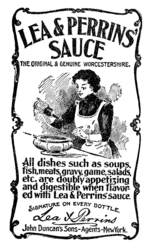
One of Worcester's most famous products is Lea & Perrins Worcestershire sauce. It has been made and bottled at a factory on Midland Road since 1897. The original Lea and Perrins shop was in the Crowngate Shopping Centre area.
Worcester is also home to Berrow's Worcester Journal. This newspaper is said to be the oldest in the world that is still being published. It started as a news-sheet in 1690.
The city has a history of metalworking. Morganite Crucible at Norton makes graphite products for modern industry. Yamazaki Mazak Corporation, a Japanese company that builds machine tools, has its European factory here. It was set up in 1980.
Worcester Heating Systems was started in the city in 1962 by Cecil Duckworth. The company was later bought by Bosch and renamed Worcester Bosch in 1996.
Shopping in Worcester
Worcester is a big shopping centre. It has several indoor shopping centres with major chain stores. There are also many independent shops and restaurants, especially on Friar Street and New Street.
The main shopping area is the High Street. It was updated in 2005 and again in 2015. There are also ongoing changes to Cathedral Plaza and Lychgate Shopping Centre.
Other important shopping streets are the Shambles and Broad Street. The Cross area is where most of Worcester's main bank branches are located.
The city centre has three main indoor shopping centres: CrownGate Shopping Centre, Cathedral Plaza, and Reindeer Court. There is also an outdoor shopping area called St Martin's Quarter. Three retail parks, Elgar, Blackpole, and Shrub Hill, offer larger stores like Asda, B&M, and Aldi.
Places to Visit in Worcester
Worcester has many interesting places to see and explore.
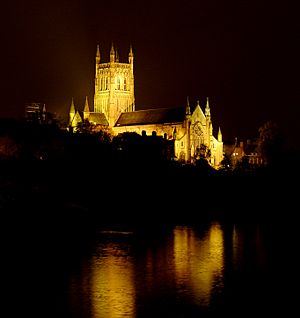
The most famous landmark is the Anglican Worcester Cathedral. It was built starting in 1084. Its crypt (underground room) is from the 11th century. It also has the only circular chapter house (meeting room) in the country. The tombs of King John and Prince Arthur are inside the cathedral.
Near the cathedral is the tall spire of St Andrew's Church, known as Glover's Needle. The rest of the church was taken down in 1949.
The Parish Church of St Helen, on the High Street, is mostly medieval. Its west tower was rebuilt in 1813.
You can see the high-water marks from the great flood of 1670 and other floods on a brass plate near the river path by the cathedral.
Worcester has many museums. These include Worcester City Art Gallery and Museum, Greyfriars' House, and the Museum of Royal Worcester. The site of the Battle of Worcester is just south of the city. Small parts of Worcester's city wall can still be seen.
The Hive is Worcester's joint public and university library and archive centre. It is on the north side of the River Severn. It is known as "the first of its kind in Europe" and stands out in the skyline. The Hive has won international awards for its design and how it uses energy.
The city's three main parks are Cripplegate Park, Gheluvelt Park, and Fort Royal Park. Fort Royal Park is on the site of an English Civil War battle. Pitchcroft, north of the city centre, is an open space used for horse racing and other public events. Gheluvelt Park remembers the brave actions of the Worcestershire Regiment in the Battle of Gheluvelt during the First World War.
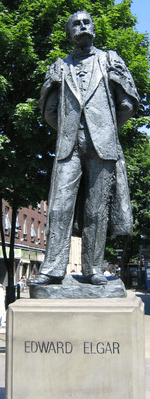
A statue of Sir Edward Elgar stands on Worcester High Street, facing the cathedral. It is near where his father's music shop used to be. Elgar was born in the nearby village of Broadheath. There are also plaques in the city, like one dedicated to the medieval Jewish community on Copenhagen Street.
Worcester has two large wooded areas: Perry Wood and Nunnery Wood. Perry Wood is sometimes said to be where Oliver Cromwell made a pact with the Devil. Nunnery Wood is next to the Worcester Woods Country Park.
Getting Around Worcester
Worcester has good transport links by road, rail, and bus.
Road Travel
The M5 Motorway runs just east of the city. You can get on it at junction 6 (Worcester North) and junction 7 (Worcester South). The M5 connects Worcester to many parts of the country, including London.
Major roads through the city include the A449 road (to Malvern and Kidderminster) and the A44 (to Evesham and Aberystwyth). The A38 goes south to Gloucester and north to Birmingham. The city is partly circled by the A4440.
The Carrington Bridge on the A4440 is the second road bridge over the Severn. It connects the A38 to the A449. This bridge is one of the busiest roads in Worcestershire. It was recently expanded to have two lanes in each direction.
Train Stations
Worcester has three railway stations. Worcester Foregate Street and Worcester Shrub Hill are in the city centre. A third station, Worcestershire Parkway, opened in 2020 on the edge of the city.
The train line crosses Foregate Street on an arched bridge. Between Foregate Street and the St John's area, the line crosses the Worcester viaduct over the River Severn.
Worcester Shrub Hill is about a mile east of the city centre. It is on a route that connects to Birmingham and Gloucester.
Both city centre stations have frequent trains to Birmingham. These trains go through Droitwich Spa, Kidderminster, and Stourbridge. They end up at Birmingham Snow Hill or Birmingham Moor Street. Trains also run from both stations to Pershore, Evesham, and on to Oxford and London.
Bus Services
The main bus company in Worcester is First Midland Red. Other smaller companies also provide services. The main bus station is Crowngate bus station in the city centre.
Worcester used to have two park and ride sites, but they were closed in 2014. One service at Sixways Stadium has since been restarted.
Air Travel
Worcester's closest major airport is Birmingham Airport. You can reach it by road and rail. Gloucestershire Airport is about 25 miles away.
Cycling in Worcester
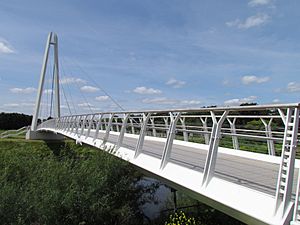
Worcester is on routes 45 and 46 of the National Cycle Network. There are many cycling routes around the city. The Diglis Bridge, a bridge for pedestrians and cyclists, opened in 2010. It connects St Peter's with Lower Wick. In 2024, Beryl bikes were introduced, allowing people to hire e-bikes and pedal bikes from 53 locations.
Waterways
The River Severn is navigable through Worcester. It connects to the Worcester and Birmingham Canal. This canal links Worcester to Birmingham and the rest of the national canal network. In the past, canals were used to transport goods. Today, they are mostly used for leisure boating.
Education in Worcester
The University of Worcester became a university in 2005. Before that, it was known as University College Worcester. From 2005 to 2010, it was the fastest-growing university in the UK. The city also has two colleges: Worcester Sixth Form College and Heart of Worcestershire College.
High Schools in Worcester
The high schools in Worcester are Bishop Perowne CofE College, Blessed Edward Oldcorne Catholic College, Christopher Whitehead Language College, Tudor Grange Academy Worcester, Nunnery Wood High School, and New College Worcester. New College Worcester is a special school for blind and partially sighted students aged 11–18.
Independent Schools
Worcester has several independent schools. The Royal Grammar School was founded in 1291. It merged with Alice Ottley School in 2007. The King's School was re-founded in 1541 by King Henry VIII. It is a school for both boys and girls, located next to Worcester Cathedral. St Mary's School, a Catholic girls' school, closed in 2014. Other independent schools include the Independent Christian School and the River School.
Hospitals in Worcester
The Worcestershire Royal Hospital is the main NHS hospital for Worcester and the surrounding county. It opened in 2002, replacing the old Worcester Royal Infirmary.
The former Worcester Eye Hospital was in Thornloe House from 1940 to 1995.
St Oswald's Hospital, originally almshouses, is now a care home.
Sports in Worcester
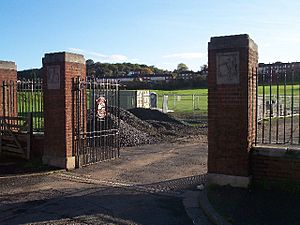
- Worcestershire County Cricket Club: Their home ground is New Road.
- Worcester City Football Club
- Worcester Sorcerers Baseball Club: Their home ground is Norton Parish Hall.
- Worcester Hockey Club: They have teams in the West Hockey Leagues.
- Worcester St Johns Cycling Club
- Worcester Wolves: A professional basketball team that plays at the Worcester Arena.
- Worcester Racecourse: Located on "Pitchcroft" by the River Severn.
Worcester's Culture
Worcester has a lively cultural scene with festivals, arts, and media.
Festivals and Shows
Every three years, Worcester hosts the Three Choirs Festival. This music festival started in the 18th century and is one of the oldest in the British Isles. It takes place in rotation between the cathedral cities of Gloucester, Hereford, and Worcester. The festival is famous for promoting English music, especially by composers like Elgar.
The Worcester Festival, started in 2003, happens in August. It includes music, theatre, cinema, and workshops. There is also a beer festival.
For one weekend each year, the city holds the Worcester Music Festival. This event features original music by local bands and musicians. All performances are free and take place in various venues around the city centre.
The Worcester Film Festival, founded in 2012, promotes filmmaking in Worcestershire. It includes screenings, workshops, and talks.
The Victorian-themed Christmas Fayre is a popular event in late November/early December. It has over 200 stalls and attracts more than 100,000 visitors.
The CAMRA Worcester Beer, Cider and Perry Festival takes place for three days in August. It is the largest beer festival in the West Midlands.
The Worcester Vegan Market started in 2021. It fills High Street and Cathedral Square with vegan vendors and food trucks.
Arts and Cinema
The famous 18th-century actress Sarah Siddons first performed at the Theatre Royal in Angel Street. Her sister, the novelist Ann Julia Kemble Hatton, was also born in the city. Vesta Tilley, a well-known male impersonator and music hall performer, was born in Worcester too.
Today, the Swan Theatre hosts professional and amateur shows. It is home to the Worcester Repertory Company. Famous actors like Imelda Staunton and Sean Pertwee started their careers here.
Huntingdon Hall is a historic church that is now a venue for music and comedy. Well-known acts like Van Morrison and Eddie Izzard have performed there.
The Marrs Bar is another venue for live music and comedy.
Worcester has two multi-screen cinemas: Vue Cinema in Friar Street and Odeon in Foregate Street.
Plans are underway to turn The Scala and Corn Exchange in Angel Place into an arts centre. This project aims to provide spaces for music, film, and other performances.
The Northwick Cinema in the northern suburb of Northwick is an Art Deco building from 1938. It has a unique interior design.
Worcester was also home to electronic music producer Mike Paradinas and his record label Planet Mu until 2007.
Media in Worcester
Newspapers
- Berrow's Worcester Journal
- Worcester News
- Worcester Observer
Radio Stations
- BBC Hereford & Worcester
- Hits Radio
- Radio Wyvern
- Heart West Midlands
- Sunshine Radio
- Capital Mid-Counties
- Smooth West Midlands
- Greatest Hits Radio
Television
Local news and TV shows for Worcester are provided by BBC West Midlands and ITV Central. These come from the Ridge Hill TV transmitter.
Twin Cities
Worcester is twinned with several cities around the world:
In 2009, Worcester City Council discussed twinning with Gaza. The idea was approved at first but later rejected due to lack of funding.
Famous People from Worcester
Many notable people have connections to Worcester:
- Hannah Snell (1723–1792): Famous for pretending to be a man and joining the Royal Marines.
- Ann Hatton (1764–1838): A writer from the Kemble family.
- James White (1775–1820): Founded the first advertising agency in London.
- Sir Charles Hastings (1794–1866): Founder of the British Medical Association.
- Philip Henry Gosse (1810–1888): A naturalist.
- Mrs. Henry Wood (1814–1887): A famous writer.
- Edward Leader Williams (1828–1910): Designed the Manchester Ship Canal.
- Benjamin Williams Leader (1831–1923): A landscape artist.
- Sir Thomas Brock (1847–1922): A sculptor, known for the London Victoria Memorial.
- Vesta Tilley (1864–1952): A music hall performer and male impersonator.
- Sir Edward Elgar (1857–1934): A world-famous composer. He lived in Worcester from a young age.
- William Morris, 1st Viscount Nuffield (1877–1963): Founder of Morris Motors.
- Geoffrey Studdert Kennedy (1883–1929): A poet and army chaplain known as "Woodbine Willy".
- Ernest Payne (1884–1961): Cyclist who won a gold medal at the 1908 Summer Olympics.
- Sheila Scott (1922–1988): An aviator.
- Louise Johnson (1940–2012): A biochemist and protein crystallographer.
- Timothy Garden, Baron Garden (1944–2007): An Air Marshal and politician.
- Dave Mason (born 1946): A musician, singer, and guitarist.
- Lee Cornes (born 1951): A comedian and actor.
- Imran Khan (born 1952): A cricketer and former Prime Minister of Pakistan. He attended the Royal Grammar School Worcester.
- Stephen Dorrell (born 1952): A Conservative politician and former government minister.
- Karl Hyde (born 1957): Musician, frontman of the group Underworld.
- Vincenzo Nicoli (born 1958): A British actor.
- Donncha O'Callaghan (born 1979): An Irish Rugby Union player.
- Ben Humphrey (born 1986): A British actor, director, and writer.
- Kit Harington (born 1986): An actor known for playing Jon Snow in Game of Thrones.
- Kai Alexander (born 1997): A British actor.
- Matt Richards (born 2002): A British swimmer and double Olympic champion.
Images for kids
-
Worcester Shrub Hill railway station with a London Midland train
See also
 In Spanish: Worcester para niños
In Spanish: Worcester para niños


